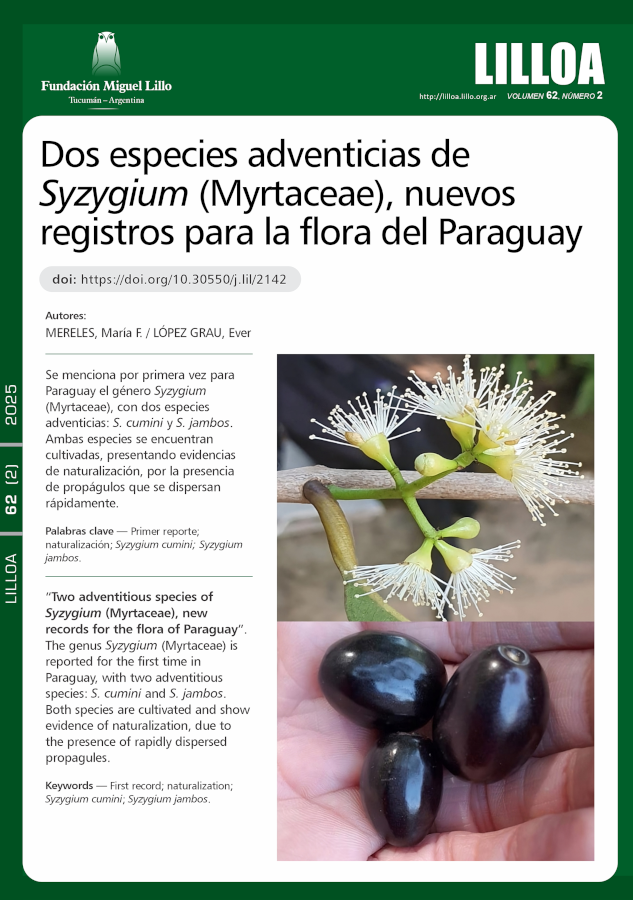Two adventitious species of Syzygium (Myrtaceae), new records for the flora of Paraguay
DOI:
Keywords:
First record, naturalization, Syzygium cumini, Syzygium jambosAbstract
The genus Syzygium (Myrtaceae) is reported for the first time in Paraguay with two adventitious species: S. cumini and S. jambos. These are two species are native to tropical Asia and parts of Australia and are widely distributed throughout the world. In Paraguay, both species are cultivated. The specimens collected were deposited in the FCQ herbarium. Since they are quite similar species, a key was developed to identify them. Both S. cumini and S. jambos flower and fruit copiously at least once a year, or more, showing evidence of their naturalization by the presence of propagules that disperse very quickly in the vicinity of the mother trees or more or less far from them. Their fruits are consumed by various animals, especially birds, small mammals such as bats, opossums, and humans.
Downloads
References
Andrade, M. V. M., Silva, D. S., Andrade, A. P., Medeiros, A. N. y Pintos, M. S. C. (2005). Fenología da Calotropis procera (Ait.) R. Br., en funcao do sistema e da densidade de plantío. Archivos da Zootecnia 54 (208): 631-634.
Barrie, F. R. (2009). Syzygium. En: G. Dadvise y M. Sousa Sánchez (Eds.), Flora Mesoamericana 4 (1): 148-150. México: Universidad Nacional Autónoma de México.
Bernardi, L. (1985). Contribución a la Dendrología Paraguaya: Myrtaceae. Boissiera 37: 151.
Brambach, F., Byng, J. W. y Culmsee, H. (2017). Five new species of Syzygium (Myrtaceae) from Sulawesi, Indonesia. PhytoKeys 81: 47-78. https://doi.org/10.3897/ DOI: https://doi.org/10.3897/phytokeys.81.13488
De Almeida, I. V. B., Monteiro do Rego, M., Rabelo Da Costa Batista, F., Ramalho do Rego, E. y Alcántara Bruno, R. (2013). Phenology of Calotropis procera (Ait.) W. T. Aiton, Accessions Based on Morphophysiological Characteristics. Revista Caatinga 32 (2): 543-545. DOI: https://doi.org/10.1590/1983-21252019v32n227rc
Govaerts, R., Sobral, M., Aschton, P., Barrie, F., Holst, B. K., Landrum, L. L., Matsumoto, K., Mazine, F. F., Nic Lughadha, E., Proenca, C., Soares-Silva, L. H., Wilson, P. G. y Lucas, E. (2019). World Checklist of. Myrtaceae. Kew Publishing, London. P. 455. http://wcso.science.kew.org/
Grau, A., Malizia, L. R. y Brown, A. D. (2016). Arboretum Calilegua. Arboles nativos y exóticos del noroeste argentino. Ediciones del Subtrópico.
Hilgert, N. I., Lambaré, D. A., Vignale, N. D., Stampella, P. C. y Pochettino, M. L. (2014). Especies naturalizadas o antropizadas? Apropiación local y la construcción de saberes sobre los frutales introducidos en época histórica en el norte de Argentina. Revista Biodiversidad Neotropical 4 (2): 69-87. DOI: https://doi.org/10.18636/bioneotropical.v4i2.118
Horkche, O., Berry, P. E. y Huber, O. (2008). Nuevo Catálogo de la Flora Vascular de Venezuela: 1-859. Fund. Inst. Bot. Venezuela.
Hurrell, J. A., Delucchi, G. y Keller, H. A. (2017). Primer registro de Syzygium jambos (Myrtaceae), naturalizada en Misiones, Argentina. Bonplandia 26 (2): 125-132. DOI: https://doi.org/10.30972/bon.2622570
Jorgensen, P. M., Nee, M. H. y Beck, S. G. (2013). Catálogo de las Plantas Vasculares de Bolivia. Monographs in Systematic Botany from the Missouri Botanical Garden 127: 1-1741.
Mc Vaugh, R. (1963). Flora of Guatemala. Fieldiana: Botany 24, part VII (3): 290-373. DOI: https://doi.org/10.5962/bhl.title.2413
Pysek, P., Richardson, D., Rejmánek, M., Webster, G., Williamson, M. y Kirschner, J. (2004). Alien plants in checklists and floras: towards better comunications between taxonomists and ecologists. Taxon 53: 131-143. DOI: https://doi.org/10.2307/4135498
Pysek, P. y Richardson, D. (2006). The biogeography of naturalization in alien plants. Journal of Biogeography 12: 2040-2050. DOI: https://doi.org/10.1111/j.1365-2699.2006.01578.x
Pizzardo, R. C. y Antonicelli, M. C. (2025). Syzygium in Flora e Funga do Brasil. Jardim Botanico do Río de Janeiro. Retrieved from: https://floradobrasil.jbrj.gov.br/FEB86017>acceso16.fev.2025
Richardson, D. M., Pysek, P., Rejmánek, M., Barbour, M. G., Panetta, F. D. y West, C. J. (2000). Naturalization and invasion of alien plants: concepts and definitions. Diversity and Distribution 6: 93-107. DOI: https://doi.org/10.1046/j.1472-4642.2000.00083.x
Richardson, D. M., Daehler, C. C., Leishman, M. R., Pauchard, A. y Pysek, P. (2010). Plant invasions: theoretical and practical challenges. Biological Invasions 12: 3907-3911. DOI: https://doi.org/10.1007/s10530-010-9845-1
Richardson, D. M., Pysek, P. y Carlton, J. T. (2011). A compendium of essential concepts and terminology in invasion ecology. En: R. M. Richardson (Ed.), Fifty Years of Invasion Ecology: The Legacy of Charles Elton (pp 409-420). Oxford: Wiley-Blackwell. DOI: https://doi.org/10.1002/9781444329988.ch30
Rodríguez Farrat, L. F., Castro Muñoz, L. M. y Salabarría Fernández, D. (2014). Especies exóticas invasoras: el caso del archipiélago cubano. Ambienta (España) 108: 62-77.
Santisuk, T., Larsen, K., Nielsen, I., Chayamarit, K., Hedge, I., Dransfield, J., Hansen, B., Phengkhlai, C., Vidal, J., Iwatsuki, K., Parnell, J. y Roos, M. (2002). Flora of Thailand: Myrtaceae. The Forest Herbarium.
Soh, W. y Parnell, J. (2015). A revision of Syzygium Gaertn. (Myrtaceae) in Indochina (Cambodia, Laos and Vietnam). Adansonia 37 (2): 179-275. DOI: https://doi.org/10.5252/a2015n2a1
Sousa Sobrinho, M., Machado Tabatinga, G., Machado, I. C. y Lopes, A. V. (2013). Reproductive phenological pattern of Calotropis procera (Apocynaceae), a invasive species in Brazil: anual in native areas; continous in invaded areas of Caatinga. Acta Botanica Brasilica 27 (2): 456-459. DOI: https://doi.org/10.1590/S0102-33062013000200018
WFO (2025). http://www.worldfloraonline.org./taxon/wfo-4000037381. Consultado 17.02.2025
Zuloaga, F. O., Belgrano, M. J. y Zanotti, C. A. (2019). Actualización del Catálogo de las Plantas Vasculares del Cono Sur. Darwiniana nueva serie 7: 208-278. http://dx.doi.org/10.14522/darwiniana.2019.72.861 DOI: https://doi.org/10.14522/darwiniana.2019.72.861
Downloads
Published
How to Cite
Issue
Section
License
Copyright (c) 1900 Lilloa

This work is licensed under a Creative Commons Attribution-NonCommercial-ShareAlike 4.0 International License.











